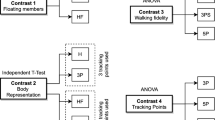Abstract
Human gait is typically influenced by the gait of other people and can be observed in real as well in virtual reality (VR) space. The projection of walking motion of various avatars on walls in VR space reveals that people’s walking speed changes even when walking alongside moving point-light dots (i.e., biological motion), not just a full-body silhouette. However, the effect of the texture or motion of the avatar on the walking speed remains unclear. In this study, we examined the effects of the changes of the texture and walking motion of a human 3D avatar on the walking speed/gait sensation. Furthermore, we investigated the effect of the presence or absence of the priming stimuli of age stereotypes on the subjects’ walking speed/gait sensation. The results revealed a significant interaction between the priming effect and avatar motion. Furthermore, gait sensation differed by motion and texture. These findings provide new insights into the control of human walking speed and the similarities and differences between psychological effects in real and VR spaces.
Access this chapter
Tax calculation will be finalised at checkout
Purchases are for personal use only
Similar content being viewed by others
Notes
References
Rio, K.W., Rhea, C.K., Warren, W.H.: Follow the leader: visual control of speed in pedestrian following. J. Vis. 14(2), 1–16 (2014)
Naoto Y., Wang C., Kazuki U., Kenji M., and Tomoko Y.: Proposal of attention guidance method based on induced behaviour of multiple virtual agents for pedestrians. Human-agent Interaction Symposium 2020. P-29, (2020) (in Japanese)
Tanizaki, M., Matsumoto, K., Narumi, T., Kuzuoka, H., Amemiya, T.: Modulation of walking speed by the change in motion and shape of the virtual avatar moving alongside. Trans. Virtual Reality Soc. Japan 26(3), 208–218 (2021). (in Japanese)
Doyen, S., Klein, O., Pichon, C.L., Cleeremans, A.: Behavioral priming: it’s all in the mind, but whose mind? PLoS ONE 7(1), 1–7 (2012)
Richard, H.T.: Nudge, not sludge. Science 361(6401), 431–431 (2018)
Perdue, C.W., Gurtman, M.B.: Evidence for the automaticity of ageism. J. Exp. Soc. Psychol. 26(3), 199–216 (1990)
Beaudoin M., Barra J., Dupraz L., Mollier-Sabet P., Guerraz M.: The impact of embodying an “elderly” body avatar on motor imagery. Exp. Brain Res. 238(6), 1467–1478 (2020)
Tammy Lin J.-H., and Wu D.-Y.: Exercising with embodied young avatars: how young vs. older avatars in virtual reality affect perceived exertion and physical activity among male and female elderly individuals. Front. Psychol. 12, 693545 (2021)
Yee, N., and Bailenson, J.N.: Walk a mile in digital shoes: the impact of embodied perspective-taking on the reduction of negative stereoty** in immersive virtual environments. In: Proceeding of the 9th Annual International Workshop on Presence. Cleveland, Ohio, USA (2006)
Yee, N., Bailenson, J.N.: The proteus effect: the effect of transformed self-representation on behavior. Hum. Commun. Res. 33, 271–290 (2007)
Wang, J., Wang, L.: Influence of affective priming effect of immersive virtual reality horror games on cognitive processing of college students. Revista Argentina de Clínica Psicológica. 29, 1213–1222 (2020)
Acknowledgement
This study was supported by JSPS Grant-in-Aid for Scientific Research (A) Grant Number 21H04883.
Author information
Authors and Affiliations
Corresponding author
Editor information
Editors and Affiliations
Rights and permissions
Copyright information
© 2023 The Author(s), under exclusive license to Springer Nature Switzerland AG
About this paper
Cite this paper
Koseki, Y., Amemiya, T. (2023). Modulation of the Walking Speed by Moving Avatars with Age Stereotype Stimuli. In: Chen, J.Y.C., Fragomeni, G., Fang, X. (eds) HCI International 2023 – Late Breaking Papers . HCII 2023. Lecture Notes in Computer Science, vol 14058. Springer, Cham. https://doi.org/10.1007/978-3-031-48050-8_7
Download citation
DOI: https://doi.org/10.1007/978-3-031-48050-8_7
Published:
Publisher Name: Springer, Cham
Print ISBN: 978-3-031-48049-2
Online ISBN: 978-3-031-48050-8
eBook Packages: Computer ScienceComputer Science (R0)




